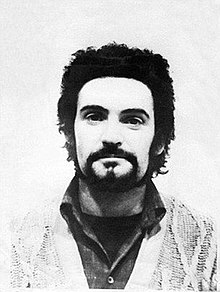
Back Peter Sutcliffe Afrikaans بيتر ساتكليف Arabic بيتر ساتكليف (سائق شاحنه من المملكه المتحده) ARZ Peter Sutcliffe Czech Peter Sutcliffe Danish Peter Sutcliffe (Serienmörder) German Peter Sutcliffe Spanish Peter Sutcliffe Basque پیتر ساتکلیف Persian Peter Sutcliffe Finnish
Peter Sutcliffe | |
|---|---|
 Sutcliffe after his arrest in Sheffield, 1981 | |
| Born | Peter William Sutcliffe 2 June 1946 Bingley, West Riding of Yorkshire, England |
| Died | 13 November 2020 (aged 74) Brasside, County Durham, England |
| Other names |
|
| Occupation | HGV driver |
| Height | 5 ft 8 in (1.73 m)[1] |
| Criminal status | Died in prison |
| Spouse | |
| Criminal penalty | Life imprisonment (whole life order) |
| Details | |
| Victims | 22+ (13 confirmed murdered, 7 confirmed injured, 2 suspected to be injured, at least 1 other officially suspected murder) |
Span of crimes | 1975–1980 (confirmed) |
| Country | United Kingdom |
| Location(s) | |
Date apprehended | 2 January 1981 |
| Imprisoned at |
|
Peter William Sutcliffe (2 June 1946 – 13 November 2020), also known as Peter Coonan, was an English serial killer who was convicted of murdering thirteen women and attempting to murder seven others between 1975 and 1980.[2]: 144 He was dubbed in press reports as the Yorkshire Ripper, an allusion to the Victorian serial killer Jack the Ripper. He was sentenced to twenty concurrent sentences of life imprisonment, which were converted to a whole life order in 2010. Two of Sutcliffe's murders took place in Manchester; all the others were in West Yorkshire. Criminal psychologist David Holmes characterised Sutcliffe as being an "extremely callous, sexually sadistic serial killer."[3]
Sutcliffe initially attacked women and girls in residential areas, but appears to have shifted his focus to red-light districts because he was attracted by the vulnerability of prostitutes and the perceived ambivalent attitude of police to prostitutes' safety.[4][5] After his arrest in Sheffield by South Yorkshire Police for driving with false number plates in January 1981, he was transferred to the custody of West Yorkshire Police, who questioned him about the killings. Sutcliffe confessed to being the perpetrator, saying that the voice of God had sent him on a mission to kill prostitutes. At his trial he pleaded not guilty to murder on grounds of diminished responsibility, but he was convicted of murder on a majority verdict. Following his conviction, Sutcliffe began using his mother's maiden name of Coonan.
The search for Sutcliffe was one of the largest and most expensive manhunts in British history. West Yorkshire Police faced heavy and sustained criticism for their failure to catch him despite having interviewed him nine times in the course of their five-year investigation. Owing to the sensational nature of the case, the police handled an exceptional amount of information, some of it misleading including hoax correspondence purporting to be from the "Ripper". Following Sutcliffe's conviction, the government ordered a review of the investigation, conducted by the Inspector of Constabulary Lawrence Byford, known as the "Byford Report". The findings were made fully public in 2006, and confirmed the validity of the criticism of the force.[6] The report led to changes to investigative procedures that were adopted across UK police forces.[7] Since his conviction, Sutcliffe has been linked to a number of other unsolved crimes.
Sutcliffe was transferred from prison to Broadmoor Hospital in March 1984 after being diagnosed with paranoid schizophrenia.[8] The High Court dismissed an appeal by Sutcliffe in 2010, confirming that he would serve a whole life order and never be released from custody. In August 2016, it was ruled that he was mentally fit to be returned to prison, and he was transferred that month to HM Prison Frankland. Sutcliffe died in the hospital from diabetes-related complications while in prison custody in 2020.
- ^ "Murderers by height". murdermiletours.com. Serial killers.
- ^ Cross, Roger (1981). The Yorkshire Ripper: The in-depth study of a mass killer and his methods. UK: Harper Collins. ISBN 978-0-586-05526-7.
- ^ Carter, Claire (13 January 2020). "How Yorkshire Ripper Peter Sutcliffe developed his murderous hatred of women". Daily Mirror. Retrieved 20 August 2023.
- ^ The Yorkshire Ripper files: A very British crime story (TV documentary). BBC TV.
- ^ "The Yorkshire Ripper files: Why Chapeltown in Leeds was the 'hunting ground' of Peter Sutcliffe". The Yorkshire Post. 27 March 2019. Retrieved 28 March 2019.
- ^ Dowling, Tim (27 March 2019). "The Yorkshire Ripper files review – a stunningly mishandled manhunt". The Guardian. Retrieved 14 November 2020.
- ^ "Sir Lawrence Byford: Yorkshire Ripper report author dies". BBC News (obituary). 12 February 2018. Retrieved 24 November 2019.
- ^ "Yorkshire Ripper Peter Sutcliffe 'was never mentally ill' claims detective who hunted him". The Daily Telegraph. 1 December 2015. Archived from the original on 11 January 2022. Retrieved 16 October 2019.